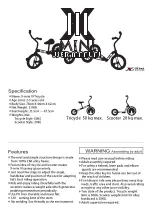
11
2.C - off-Road safety
We recommend that children not ride on rough
terrain unless they are accompanied by an adult.
1. The variable conditions and hazards of off-road
riding require close attention and specific skills.
Start slowly on easier terrain and build up your
skills. If your bike has suspension, the increased
speed you may develop also increases your risk
of losing control and falling. Get to know how
to handle your bike safely before trying increased
speed or more difficult terrain.
2. Wear safety gear appropriate to the kind of riding
you plan to do.
3. Don’t ride alone in remote areas. Even when
riding with others, make sure that someone
knows where you’re going and when you expect
to be back.
4. Always take along some kind of identification,
so that people know who you are in case of an
accident; and take along a couple of dollars in
cash for a candy bar, a cool drink or an emergency
phone call.
5. Yield right of way to pedestrians and animals.
Ride in a way that does not frighten or endanger
them, and give them enough room so that their
unexpected moves don’t endanger you.
6. Be prepared. If something goes wrong while
you’re riding off-road, help may not be close.
7. Before you attempt to jump, do stunt riding
or race with your bike, read and understand
SECTION 2.F.
off-Road Respect
Obey the local laws regulating where and how you
can ride off-road, and respect private property.
You may be sharing the trail with others — hikers,
equestrians, other cyclists. Respect their rights. Stay
on the designated trail. Don’t contribute to erosion
by riding in mud or with unnecessary sliding. Don’t
disturb the ecosystem by cutting your own trail
or shortcut through vegetation or streams. It is
your responsibility to minimize your impact on the
environment. Leave things as you found them; and
always take out everything you brought in.
2.d - Wet WeatheR RidinG
Under wet conditions, the stopping power of your
brakes (as well as the brakes of other vehicles sharing
the road) is dramatically reduced and your tires don’t
grip nearly as well. This makes it harder to control
speed and easier to lose control.
WaRninG
Wet WeatheR imPaiRs tRaCtion, BRakinG
and visiBility, Both foR the BiCyClist
and foR otheR vehiCles shaRinG the
Road.
the risk of an accident is dramatically
increased in wet conditions.
To make sure that you can slow down and stop safely
in wet conditions, ride more slowly and apply your
brakes earlier and more gradually than you would
under normal, dry conditions. See also SECTION 4.C.
Summary of Contents for Synapse Carbon
Page 1: ......
Page 2: ......
Page 31: ...29 Figure 11 Figure 12 Figure 13 Figure 14 Figure 15 OPEN OPEN OPEN PUSH...
Page 65: ...63 This page has been left blank intentionally...
Page 99: ......
Page 100: ......
Page 101: ......
Page 102: ......














































